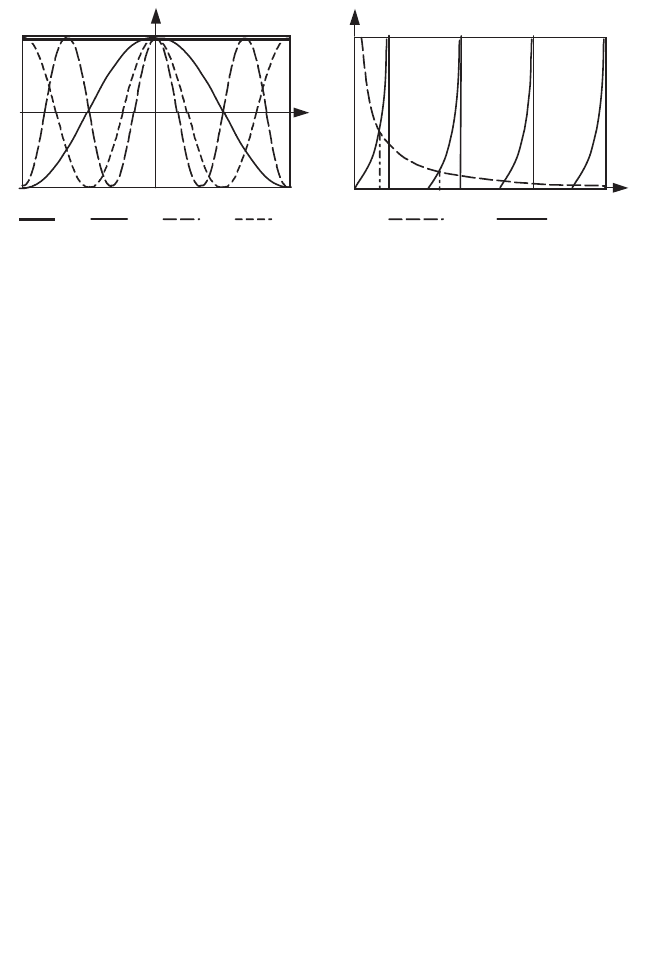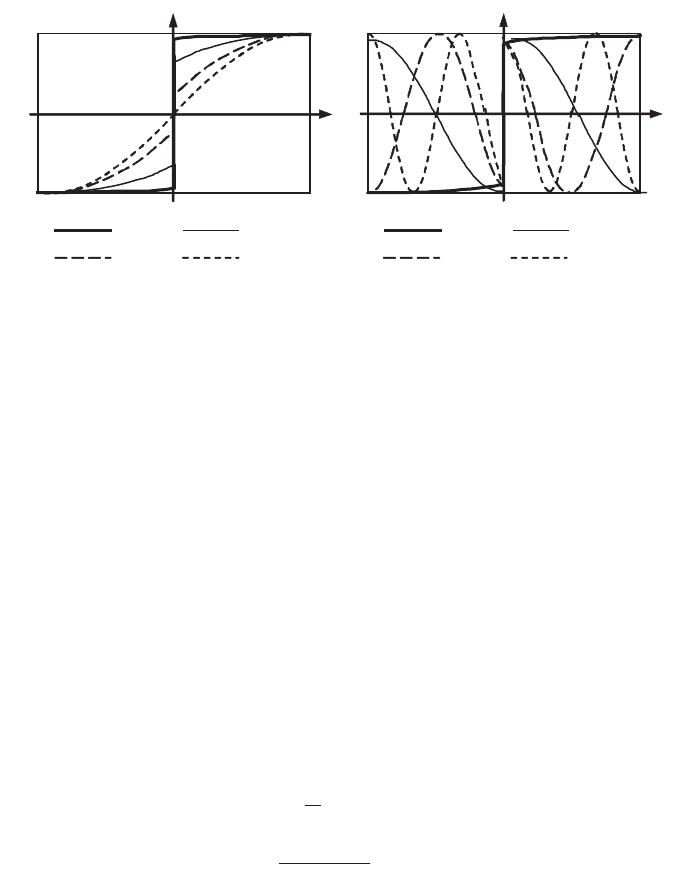Peube J-L. Fundamentals of fluid mechanics and transport phenomena
Подождите немного. Документ загружается.


442 Fundamentals of Fluid Mechanics and Transport Phenomena
-1 +1
x
~
g
i
: g
2
: g
4
: g
6
: g
0
+1
-1
/
0
S S S SS S S
: 2P/
/
: tan
/
/
/
/
/
(a) (b)
Figure 8.15.
(a) Even eigenfunctions of two walls separate by a thermal resistance;
(b) graphical solution of the eigenvalue equation in the case of odd eigenfunctions
2) Odd eigenfunctions. Substituting the values [8.51] of the pairs (B
–
, B
+
) into
first relation [8.52], we obtain a second group of solutions
(0, 0):
BB
vv
or BB;AA BB;AA
S
We derive the relation:
BABA cos.cos.
Substituting this expression into [8.52], and taking account of [8.51], we obtain
the eigenvalue equation:
P2tan // [8.54]
whose graphical solution is shown in Figure 8.15b. The eigenfunctions
xg
k
~
12
which correspond to these eigenvalues are here odd and by taking
1
AA
they present a discontinuity amplitude equal to
12
cos2
/
k
at the origin. They can
be written:
1
~
cos)
~
(:10
121212
/ d
xAxgx
kkk
These discontinuous eigenfunctions depend on the dimensionless parameter P.
We have represented, in Figure 8.16b, the first four odd eigenfunctions
corresponding to
05.0 P
(eigenvalues /
1
=0.3111, /
3
=3.1731, /
5
=6.2991,
/
7
=9.43538).

Thermal Systems and Models 443
x
~
+1
-
1
g
1
P =0.05 P =0.5
: g
5
: g
7
+
1
-
1
g
i
: g
1
: g
3
P =3
P = f
(a) Variations of the eigenfunction
g
1
for different values of P.
(b) Discontinuous eigenvalues for
P = 0.05.
+1+1
–
1
–
1
x
~
Figure 8.16.
Odd eigenvalues for two walls separated by a thermal resistance
8.3.2.3.3.
Evolution of odd eigenfunctions
The value of thermal resistance placed between the two walls (in other words the
value of P) has a strong influence on the discontinuity amplitude. Figure 8.16a
shows the evolution of the first odd eigenfunction as a function of P. The small
values of P (high thermal resistance R) lead to eigenvalues of the odd functions
which are thus quite close to k
S
, which are the eigenvalues of the even functions
(Figure 8.15b). The discontinuity at the origin
21
2cos
k
/
of the odd eigenfunctions
is strong, and the thermal flux
1212
sin
//
kk
between the two blocks is all the
smaller as k is large. The absolute values of the odd and even eigenfunctions are thus
very close in each of the two continuous media. A homogenization of the
temperature occurs in each block, the thermal flux
1212
sin
//
kk
between them
being essentially limited to the first odd mode.
If the thermal resistance R tends to zero, P becomes large and the eigenvalues
12
/
k
tend to the odd eigenvalues
S
S
k
2
of the total isolated system. We thus
find the odd eigenfunctions
21
sin
2
kx
S
of the conduction problem for an
insulated wall (and of course, the temperature continuity at the origin).
In expression [8.17] of the modal development of the temperature, the
dimensional time constant
W
k
of each mode is directly related (formulae [8.33] and
[8.36]) to the corresponding eigenvalue /
k
:

444 Fundamentals of Fluid Mechanics and Transport Phenomena
22
kk
a/ A
W
For small values of P, the first term of the development of /
1
as a function of P
is equal to
P2 (equation [8.54]). Substituting this value into the above expression
and replacing P by
R
O
A , we find for the time constant
W
1
:
22
2
2
1
2
1
RC
aP
a
AAA
U
W
/
We find the time constant of the thermodynamic model of section 8.3.1.2 in the
particular case where we have R' = 0, with
A
U
m .
8.3.2.3.4.
Expression of the solution
The complete solution of the problem can be obtained from formula [8.18] as the
development of the difference
)0,()0,( xTxT
e
as a series of eigenfunctions of the
problem; these are orthogonal if the operator of the problem is self-adjoint
(Appendix 4). The verification of this property can be checked easily by separately
considering the intervals [-1,0
–
] and [0
+
,1]; and taking account of the condition
01' g , we have, after integration by parts, for p not equal to q:
³³³
0
1
'''
0
1
'
0
1
''
~
00
~
xdggggdggxdgg
qpqpqpqp
Proceeding in a similar manner for the other interval, we obtain:
>@
³
00000000
~
''''
1
1
''''
pqqppqqp
pqqp
gggggggg
xdgggg
Taking account of conditions [8.48] for the thermal resistance at x = 0 and after
replacing
''
p
g
and
''
q
g
by their expressions taken from equation [8.50], we see that
the integral
1
'' ''
1
pq qp
gg gg dx
¯
¡°
¢±
¨
is zero if p is not equal to q:
11
'' '' 2 2
11
0
pq qp p q pq
gg gg dx ggdx
//
¯
¡°
¢±
¨¨
The eigenfunctions g
p
and g
q
are orthogonal for the scalar product
xdfggf
~
,
1
1
³
! .

Thermal Systems and Models 445
The complete solution [8.18] can be written:
¦
f
/
¸
¹
·
¨
©
§
0
12
~
12
~
2
)
~
()
~
cos()
~
,
~
()
~
,
~
(
2
12
22
k
k
t
k
tk
ke
xgecxkectxTtxT
k
S
S
[8.55]
>@
>@>@
1
21
1
21
1
2
21
1
11
02
11
00
with 0 1 2
1
00 00 12
2
³
³
³³
ek
k
k
ek e
T( x, ) T ( x, ) g ( x)dx
c k , , ,...,n,...
g(x)dx
c T( x, ) T ( x, ) dx; c T( x, ) T ( x, ) cos( k x )dx k , ,...,n,...
S
8.3.2.4. Modal representation of systems and number of parameters
The modal representation of a discrete system consists of replacing the n state
variables
tx
i
, functions of time, with n coefficients c
i
of the expression of the
solution on the basis of the eigenfunctions whose time dependence is known. We
thus see that, assuming the eigenfunctions to be known, the number of numerical
values (series development coefficients) which characterize the solution decreases
with time.
The same is true for the preceding models for continuous media, for which we
replace the temperature distribution T(x,t) in two continuous variables by a
denumerable sequence of series development coefficients c
i
[8.55] of eigenfunctions
associated with the physical model used. In a manner analogous to the development
of a periodic function in a Fourier series, the information necessary to characterize
the solution has been considerably reduced through the use of basis functions
adapted to the problem.
Furthermore, these developments offer the advantage that they provide an
organization of information. We saw in Chapter 7 that the frequencies associated
with the terms of a Fourier series are greater as the order of these terms is high. This
thus results in criteria regarding: the nature of the approximation which has been
made where only a limited number of terms are retained, and regarding the sampling
of the corresponding temporal signals (Shannon’s theorem). The modal
representation of thermal systems indicates that the wealth of information decreases
as time increases. For continuous media, this information diffuses from the wall and
becomes progressively poorer. The results are that the representation using space-
time numerical data (x,t) is very variable. During the first instants, we need to
discretize the time and near-wall zones very densely, while the central zone of the
wall is not subjected to any phenomenon. For larger times, the entire wall needs to
be discretized, but less densely, and the same goes for the time variable. We will
note that, as the modes vanish successively, the quantity of information contained in
446 Fundamentals of Fluid Mechanics and Transport Phenomena
the solution decays with time, the effect of the second law of thermodynamics
(increasing entropy) being to homogenize the temperature.
8.4. External representation of linear invariant
systems
8.4.1. Overview
Transitional solutions of differential system [8.13] of n linear first order
differential equations with n unknowns form a vector space of dimension n. They
allow the characterization of all possible states described by [8.13]. In practice, it
often happens that the initial data of a category of problems is of reduced number p,
the system starting for example from a given standard state (rest for example). The
transitional solutions which correspond to these initial conditions belong to a family
which depends only on these p parameters. The state representation of a system of n
state variables thus constitutes an overly detailed model. Rather than establishing a
state representation, we can be satisfied with the study of system responses by
means of an external representation by limiting ourselves to the effective inputs and
initial conditions.
Consider for example a linear invariant system for which the inputs are zero.
This is the modeling of an isolated homogenous system which evolves towards
equilibrium and which is characterized by a zero value for the state vector and the
outputs. Suppose that we impose as initial conditions given values (step functions
for example) for p components (p < n) of the state vector, the other components
being zero. This initial vector must be decomposed on eigenvectors of the
homogenous system, and apart from some particular cases, none of these
components is zero. The responses to these excitations comprise the n eigenmodes,
but they belong to a family of only p parameters which form a vector sub-space of
dimension p of the output space, which we can study directly.
8.4.2. External description of linear invariant systems
8.4.2.1.
Impulse response
The solution corresponding to diverse inputs and initial conditions is the sum of
solutions for each of the inputs and initial conditions taken separately, the others
being considered zero. This superposition property for solutions of time-invariant
linear systems allows us to separately study the response to different inputs and
initial conditions.
Consider firstly a system with a single input u
1
to which we apply a Dirac
distribution at the initial instant, the system being initially at rest; the output vector

Thermal Systems and Models 447
th
Y1
represents the evolution of the system outputs to this impulse on the first
input. Now, any given input
tu
1
can be considered as the superposition of Dirac
distributions:
WWGW
dtutu
³
f
0
11
The response
tY
1
of the system outputs to the excitation
tu
1
can be written:
WWW
duthtY
Y
.
0
111
³
f
[8.56]
The impulse response of the output vector therefore makes the characterization
of the response of a stationary linear system to any input excitation possible.
Proceeding similarly for the group of p inputs, we obtain a rectangular matrix
ththth
YpYY
,...,,
21
of dimension q
*
p formed with the p corresponding output
vectors, the entire group of which constitutes the matrix
)(tH
Y
of the impulse
response output vectors of the system. This allows us to calculate the output
corresponding to any given input vector
)(tU :
WWW
dUtHtY
Y
..
0
³
f
[8.57]
The impulse response matrix
)(tH
Y
constitutes an external description of the
system taken to be initially at rest. Easily realizable experimentally, it can be
obtained using only impulse excitations, without any knowledge of the internal
variables in the initial reference state. It also allows us to describe the evolutions
corresponding to the given non-zero initial states of the system which are obtainable
by using suitable impulses on the inputs (section 8.2.1.5).
As an input vector is usually of smaller dimension than the state vector, the
impulse response matrix
)(tH
Y
is a reduced model of the system adapted to its
operating conditions and which is not equivalent to the state representation of
section 8.1.2.
This matrix contains p*q time functions whose useful duration is equal to a
number of times the largest damping time constant. The quantity of information is
here much greater than in the case of the state representation: this is the result of the
absence of a model. For the linear time-invariant
5
thermal system, each of the
5
Responses of stable systems usually studied in fluid mechanics and acoustics present an
oscillatory damped character.

448 Fundamentals of Fluid Mechanics and Transport Phenomena
functions is a sum of decaying exponentials which we can seek to identify
approximately, at least for the first of these. In the absence of a state representation,
any interpretation of results is difficult and the obtaining of the structure of the
eigenmodes of the system is problematic.
The result of formula [8.57] is that at a given instant, the state of a linear
invariant system depends only on the inputs belonging to a past which is at most
equal to the duration of the impulse response.
NOTE – The preceding procedure can also be applied to a state vector X(t). The
application of a Dirac impulse as an input of index i provides the state vector
th
Xi
.
Operating in a similar fashion on the ensemble of inputs, we obtain the matrix
)(tH
X
of impulse responses of the state vector, of dimension n
*
p, which allows us
to obtain the response of the state vector to any given input U(t):
WWW
dUtHtX
X
..
0
³
f
However, the direct measurement of state variables is not easy in general, and
the impulse response matrix
)(tH
X
of the state vector is only of limited interest.
8.4.2.2.
Inputs-outputs analytic representation
The complete external representation of a system can be obtained from its state
representation, cast in the form of a scalar differential equation of order n (section
5.1.1 and section 8.1.2) in a scalar state variable x (t). Let us take the simple
example (n = 3) of the state representation with a single output y(t):
''';''''''
2103210
xdxdxdyuxaxaxaxa
[8.58]
Calculating the linear combination
'''
210
ududud
and eliminating x(t) and its
derivatives with [8.58], we obtain a differential equation for the output y (t):
'''''''''
2103210
udududyayayaya
[8.59]
The method can be generalized to a differential equation of arbitrary order:
¦¦
p
k
k
jkj
n
i
i
i
xdyuxa
00
;
[8.60]
We obtain:

Thermal Systems and Models 449
¦¦¦¦
p
k
k
jk
n
i
p
k
ki
jki
n
i
i
j
i
udxdaya
0000
[8.61]
The inverse passage of the preceding external representation to a state
representation can be achieved easily, the coefficients of relations [8.60] and [8.61]
(or [8.58] and [8.59]) being identical.
The representation of a dynamic system of n variables, effected by means of a
differential equation of order n, can be replaced by a relation of a differential
nature between the inputs and the outputs. However, obtaining the preceding
external representations by means of measurements, without any knowledge of the
structure of the system, is impractical for complex systems: the evaluation of the
temporal derivatives obtained from differences between measurements lead to errors
which will be greater as the order of the differentiation is increased.
8.4.2.3.
Example of a thermal system with two variables
As an example, consider the state representation of the two-component system of
section 8.3.1.2:
2222121
'
21212111
'
1
; uTaTaTuTaTaT [8.62]
where the quantities u
i
and a
ij
are defined in equation [8.21]:
2,1
'
;
1
;
'
111
21122211
¸
¸
¹
·
¨
¨
©
§
i
mCR
T
u
mCR
aa
RRmC
aa
iex
i
.
Differentiating the first equation [8.62] and eliminating
'
2
T
by means of second
relation [8.62], we obtain a second order differential equation satisfied by T
1
:
212
'
1122
''
1
'
12211121122211
uauuaTTaaTaaaa [8.63]
Taking the output variable in the form [8.58]:
'
1110
TdTdy
, the external
representation can be obtained from [8.59]:
''''
10221121122211
ududyyaayaaaa [8.64]
with:
212
'
1122
uauuau .

450 Fundamentals of Fluid Mechanics and Transport Phenomena
8.4.2.4.
Laplace transforms and operational transfer matrices
We have already seen in Chapter 7 the value of Fourier transforms for the study
of oscillatory signals. The Laplace transform (Appendix 1) presents an analogous
interest for the study of aperiodic signals and damped systems. The Laplace
transform L
f
of a function f(t) is defined by the relation:
³
f
0
dtetfpL
pt
f
[8.65]
It possesses diverse properties which are analogous to those of the Fourier
transform (section 7.3.4.2); in particular, the Laplace transform of the derivative
function f is written:
0
'
fppLpL
ff
This property allows us to transform the system of differential equations and the
initial conditions into a system of algebraic equations between the transforms of the
variables. For example, the differential equation transform:
tukxxfxm
can be written:
ux
LxpxLkpfpm 0'0
2
or:
kpfpm
xpxpL
pL
u
x
2
00
[8.66]
We thus obtain the transform of the complete solution written as a function of
the initial conditions and the transform L
u
(p) of the right-hand side (the input). All
that remains is to perform the inverse transform (Appendix 1).
The transform linearity allows it to be applied to a vector or to a matrix of
functions. For the initial conditions
0X , the Laplace transform of the state
representation [8.1] of a linear invariant dynamic system can be written:
XYUXX
LDLLBALXpL .;.0

Thermal Systems and Models 451
We can thus deduce the transforms of the solution
tX and of the output vector
tY :
-1
0: . .
XUYX
Lp pIA BLp X L DL
¯
¢±
[3.67]
As the inverse of a matrix M is equal to the ratio between the transpose of its
comatrix
6
and its determinant ([HAR 98]), the elements of the matrix
1
ApI
of
rank n are rational fractions whose denominator is equal to
ApI
, the numerator
being a polynomial in p whose order is at least equal to n. This rational fraction can
be decomposed into simple elements associated with the poles (zeros of the
denominator) which are the eigenvalues of the system studied. Each of these
elements is the Laplace transform of the real or complex exponential functions
which correspond to the eigenmodes of the system studied.
The matrix
BApIDpH
1
.
is the operational transfer matrix of the
system:
pLpHpLBApIDpL
UUY
...
1
[3.68]
As the Laplace transform of a Dirac distribution at instant t = 0 is equal to 1, the
transfer matrix
pH is the Laplace transform of the impulse response matrix
)(tH
Y
.
The Laplace transform is particularly useful in the domain of system controls
which are essentially beyond the scope of this textbook, despite applications in the
domain of flow and transfer phenomena.
8.5. Parametric models
8.5.1. Definition of model parameters
A parametric model can be defined as an exact or approximate solution whose
state vector X(t) can be written in the form of a combination (linear or otherwise) of
some state vectors X
j
(t) independent of the inputs; the coefficients Pj of this
combination are time functions which are deduced from the input vector
)(tU
(the
coefficients Pj are functionals of
tU ). For a linear combination, we have:
6
I.e. the matrix of cofactors of each element.
